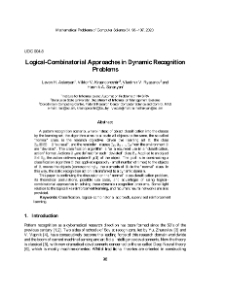Object
Title: Logical-Combinatorial Approaches in Dynamic Recognition Problems ; Логико-комбинаторные методы в задачах динамического распознавания
Co-author(s) :
Krasnoproshin Viktor V. ; Ryazanov Vladimir V. ; Sahakyan Hasmik A. ; Краснопрошин В. ; Рязанов Владимир В. ; Саакян Асмик А.
Abstract:
A pattern recognition scenario, where instead of object classification into the classes by the learning set, the algorithm aims to allocate all objects to the same, the so-called "normal" class, is the research objective. Given the learning set ; the class “normal”, and the reminder classes, from the environment are “deviated”. The classification algorithm is for a recurrent use in a "classification, action" format. Actions are defined for each “deviated” class. Applied to an object ∈, the action delivers update of the object. The goal is in constructing a classification algorithm that applied repeatedly (small number of times) to the objects of, moves the objects (correspondingly, the elements of ) to the “normal” class. In this way, the static recognition action is transferred to a dynamic domain. This paper is continuing the discussion on the “normal” class classification problem, its theoretical postulations, possible use cases, and advantages of using logicalcombinatorial approaches in solving these dynamic recognition problems. Some light relation to the topics like reinforcement learning, and recurrent neural networks are also provided
;
Рассматривается новая важная процедура в области распознавания образов, где вместо точной классификации объектов по обучающему набору, ставится альтернативная цель отнесения всех объектов к одному и тому же, к так называемому, «нормальному» классу. Задан обучающий набор; среди классов есть один «нормальный» класс , и «отклоненных» классов, в некоторой среде . Процесс обучения является динамическим в формате «классификация, действие» следующим образом: определенное действие/функция C прикрепляется к каждому из «отклоненных» классов , так что применяя действие C к произвольному объекту ∈ , его обновление C) остается в среде . В результате, C) может быть отнесен либо к одному из отклоненных классов (включая тот же класс ), либо к «нормальному» классу . Задача заключается в построении такого алгоритма классификации , который, многократно (небольшое количество раз) применявшийся к объектам, переводит объекты (соответственно, элементы ) в «нормальный» класс. Таким образом, статическое распознавание переносится в область динамического распознавания. Статья представляет обсуждение проблемы, ее теоретических постулатов, возможные применения на практике, а также выявление преимуществ использования логико-комбинаторных подходов при решении этих задач динамического распознавания. Учитывается отношение к таким темам, как обучение с подкреплением, логико-комбинаторное распознавание и рекуррентные нейронные сети.
Date submitted:
Identifier:
oai:noad.sci.am:136084
Language:
Journal or Publication Title:
Mathematical Problems of Computer Science ; Математические вопросы кибернетики и вычислительной техники
Number:
Affiliation:
Institute for Informatics and Automation Problems of NAS RA ; Belarusian State University, Department of Information Management Systems ; Dorodnitsyn Computing Centre, Federal Research Center Computer Science and Control, RAS
Year:
Object collections:
- Digital Library > Academic Insitutions > Insitute for Informatics and Automation Problems of NAS RA > Publications
Last modified:
May 3, 2021
In our library since:
Mar 13, 2021
Number of object content hits:
93
All available object's versions:
https://noad.sci.am/publication/149744
Show description in RDF format:
Show description in OAI-PMH format:
| Edition name | Date |
|---|---|
| Асланян Левон, Логико-комбинаторные методы в задачах динамического распознавания | May 3, 2021 |





